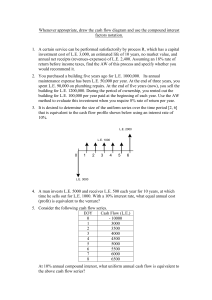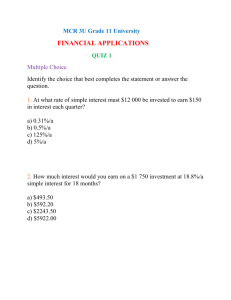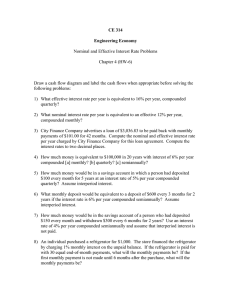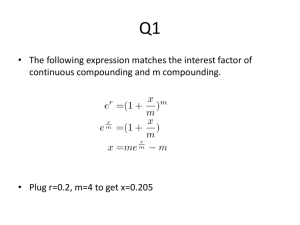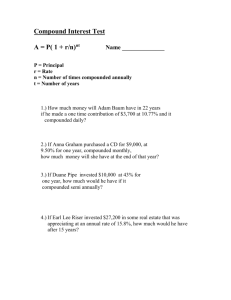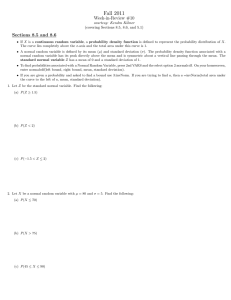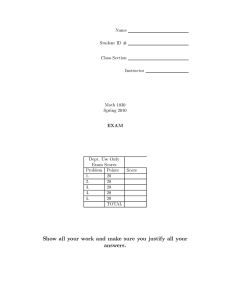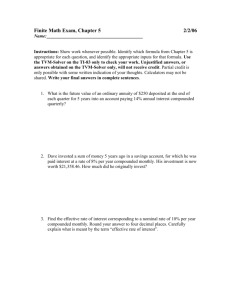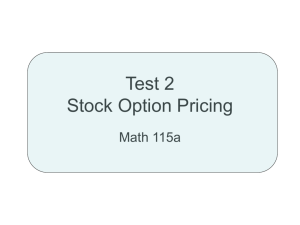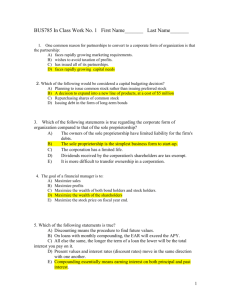Engineering Economics
advertisement
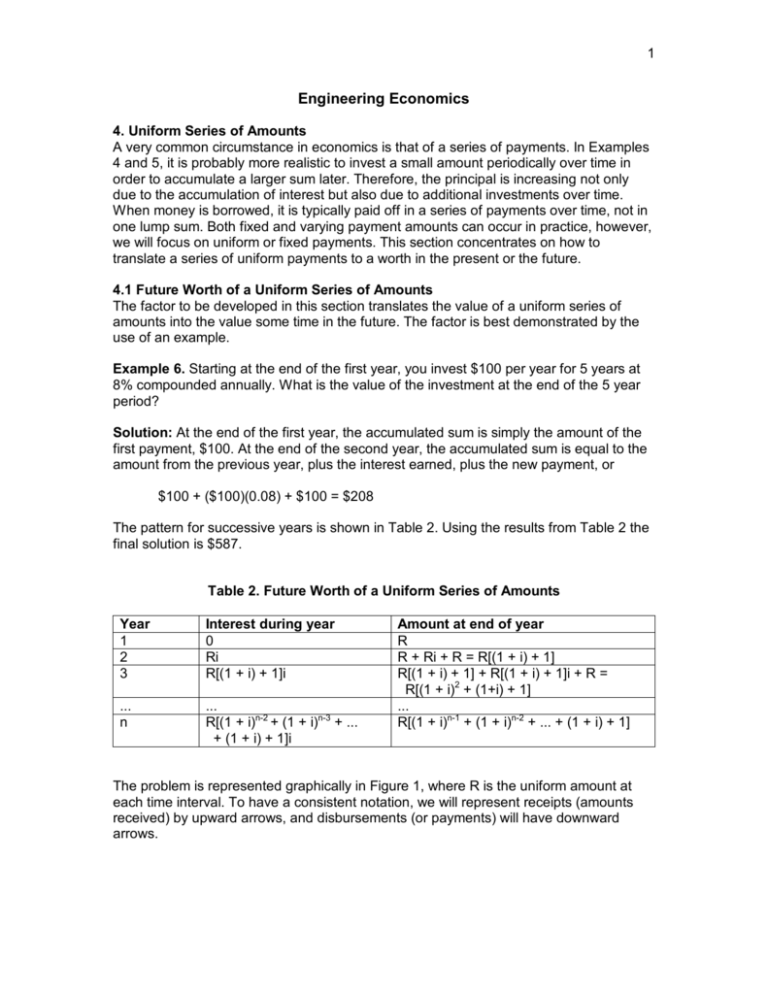
1 Engineering Economics 4. Uniform Series of Amounts A very common circumstance in economics is that of a series of payments. In Examples 4 and 5, it is probably more realistic to invest a small amount periodically over time in order to accumulate a larger sum later. Therefore, the principal is increasing not only due to the accumulation of interest but also due to additional investments over time. When money is borrowed, it is typically paid off in a series of payments over time, not in one lump sum. Both fixed and varying payment amounts can occur in practice, however, we will focus on uniform or fixed payments. This section concentrates on how to translate a series of uniform payments to a worth in the present or the future. 4.1 Future Worth of a Uniform Series of Amounts The factor to be developed in this section translates the value of a uniform series of amounts into the value some time in the future. The factor is best demonstrated by the use of an example. Example 6. Starting at the end of the first year, you invest $100 per year for 5 years at 8% compounded annually. What is the value of the investment at the end of the 5 year period? Solution: At the end of the first year, the accumulated sum is simply the amount of the first payment, $100. At the end of the second year, the accumulated sum is equal to the amount from the previous year, plus the interest earned, plus the new payment, or $100 + ($100)(0.08) + $100 = $208 The pattern for successive years is shown in Table 2. Using the results from Table 2 the final solution is $587. Table 2. Future Worth of a Uniform Series of Amounts Year 1 2 3 Interest during year 0 Ri R[(1 + i) + 1]i ... n ... R[(1 + i)n-2 + (1 + i)n-3 + ... + (1 + i) + 1]i Amount at end of year R R + Ri + R = R[(1 + i) + 1] R[(1 + i) + 1] + R[(1 + i) + 1]i + R = R[(1 + i)2 + (1+i) + 1] ... R[(1 + i)n-1 + (1 + i)n-2 + ... + (1 + i) + 1] The problem is represented graphically in Figure 1, where R is the uniform amount at each time interval. To have a consistent notation, we will represent receipts (amounts received) by upward arrows, and disbursements (or payments) will have downward arrows. 2 Future Worth 0 1 2 3 R 4 5 Time Figure 1. Future Worth of a Series of Amounts The final result shown in Table 2 can be more compactly presented and the result is called the Series-Compound-Amount Factor (SCAF or f/a). The Series-CompoundAmount Factor is f (1 + i) n − 1 = a i The inverse of f/a is called the Sinking-Fund Factor (SFF or a/f) a i = f (1 + i)n − 1 The application of these factors is Future Worth = (Series Amount)(f/a) and Series Amount = (Future Worth)(a/f) These equations can be modified to accommodate multiple compounding periods per year. Simply divide the nominal annual interest rate, i, by the number of compounding periods per year, m, and multiply the number of years, n, by the number of compounding periods per year. Keep in mind that that the series amounts are assumed to be made available at the same frequency at which the interest is compounded. More frequent compounding than series amounts can be accommodated and this will be seen later. It is worthwhile to emphasize one important point. Whenever the equations above for f/a or a/f are applied, the convention is that the first amount is made available at the end of the first year. Sometimes when a series is to be evaluated, the first amount may be available at time 0 instead; such conversions can be made and will be explained later. Example 7. You are thinking about retirement and you are considering investing money each month so you will have $100,000 in thirty years. If the nominal annual interest rate is 8% and the interest is compounded monthly, calculate the monthly investment amount. 3 Solution: The future worth of the investment is given as $100,000. The desired quantity is the series amount. Therefore, the Sinking-Fund Factor is used Series Amount = (Future Worth)( a 0.08 , i= , 12 × 30 periods) f 12 0.08 a 0.08 12 =6.7098×10-4 , 12 × 30 periods) = ( , i= 0 . 08 f 12 (1 + )12×30 − 1 12 and Series Amount = ($100,000)(6.7098×10-4) = $67.10 Therefore, you must invest $67.10 per month in order to have $100,000 in thirty years. 4.2 Present Worth of a Uniform Series of Amounts The Series-Present-Worth Factor (SPWF of p/a) translates the value of a series of uniform amounts R into the present worth, as shown symbolically in Figure 2. Present Worth 0 1 2 3 R 4 5 Time Figure 2. Present Worth of a Series of Amounts As in the previous section, the convention is that the first payment occurs at the end of the first time period and not at time 0. The Series-Present-Worth Factor (p/a) can be determined using the procedures from the previous section. Alternately, p/a can be determined using the previously derived factors. p p f 1 (1 + i) n − 1 (1 + i)n − 1 = ⋅ = ⋅ = a f a (1 + i) n i i(1 + i)n The reciprocal of p/a is the Capital-Recovery Factor (CRF or a/p) 4 a i(1 + i) n = p (1 + i) n − 1 Again, both of these formulas can be used with more compounding periods per year as done in the previous sections. Also, remember that the series amounts are assumed to be made available at the same frequency at which the interest is compounded. An example follows which demonstrates the use of the SPWF (p/a). Example 8. Congratulations, you won $1,000,000 in the lottery. Unfortunately, the lottery commission will not pay you the entire amount now. Instead, they will pay you $50,000 each year for the next 20 years, starting at the end of the first year. What is the present worth of your winnings? Assume a nominal annual interest rate of 10%. Solution: Present worth = (Series Amount)( ( p , i=0.1, 20 years) a (1 + 0.1) 20 − 1 p , i=0.01, 20 years)= =8.5136 a 0.1(1 + 0.1) 20 and Present Worth = ($50,000)(8.5136)=$425,678 Therefore, you haven't even won one-half million dollars. Example 9. You have accumulated $5,000 in credit card debt. The credit card company charges 18% nominal annual interest compounded monthly. You can only afford to pay $100 per month. How many months will it take you to pay off the debt and how much money will you have paid in interest? Solution: $5,000 = $100( p 0.18 , i= , 12 × n periods) a 12 0.18 12×n ) − 1 12 5000 = 100 0.18 0.18 12×n (1 + ) 12 12 (1 + Rearranging and solving for n yields (1 + and 0.18 12×n ) =4 12 5 n= 4 0.18 12 ln(1 + ) 12 = 27.99 years or 335.8 months And the amount of interest paid is 335.8 × $100 - $5,000 = $28,583 5. Gradient-Present-Worth Factor The factors p/a and f/a and their reciprocals apply where the amounts in the series are uniform. For some cases, the series amounts may not be uniform but may increase over time. Typical examples of series amounts which may increase over time are maintenance costs or energy costs. The cost of maintenance of equipment is expected to increase progressively as the equipment ages, and energy costs may be projected to increase in the future. The Gradient-Present-Worth Factor (GPWF) can be used to determine the present worth of a series of amounts which increase linearly with time. The GPWF applies when there is no cost during the first year, a cost G at the end of the second year, 2G at the end of the third year, and so on, as shown in Figure 3. The present worth of this series of increasing amounts is the sum of the individual present worths Present Worth = G 2G (n − 1)G + + ... + 2 3 (1 + i) (1 + i) (1 + i) n The series can be expressed in closed form as n n 1 (1 + i) − 1 Present Worth = G(GPWF) = G − n n (1 + i) i i(1 + i) The GPWF can also be used in cases where the series amounts are not zero at year 1, but still increase linearly over time. This is demonstrated in the following example. 0 1 2 3 G 4 2G 5 3G 4G Time Figure 3. Gradient Series Example 10. The annual maintenance costs for a facility are $2,000 for the first year (assumed payable at the end of the first year) and increase by 15% each year thereafter (see Figure 4). Assuming a facility life of 15 years, what is the present worth of the 6 maintenance costs over the lifetime of the facility if the interest rate is 8% compounded annually. Solution: The series of amounts shown in Figure 4 could be reproduced by a combination of two series, a uniform series of $2,000 and a gradient series in which the gradient is $300 per year. Present Worth = $2,000( ( p , i=0.08, 15 years) + $300(GPWF, i=0.08, 15 years) a p , i=0.08, 15 years) = 8.5595 a 15 15 1 (1 + 0.08) − 1 (GPWF, i=0.08, 15 years) = = 47.886 − 15 15 (1 + 0.08) 0.08 0.08(1 + 0.08) Therefore Present Worth = $2,000(8.5595) + $300(47.886) = $31,485 0 1 2 3 4 5 Time Maintenance Cost ($) $2,000 $2,300 $2,600 Figure 4. Maintenance Costs for Example Problem 10 6. Summary of Interest Factors The factors p/f, f/a, p/a and their reciprocals, and the GPWF are tools that can be applied and combined to solve numerous problems of engineering economics. These factors are summarized in Table 3. Following sections will illustrate how these factors can be combined to solve more complicated problems. In most of these problems, the solution depends on setting up an equation that expresses the equivalence of amounts existing at different times. Many of these problems are solved by translating different amounts to the same basis, such as the future worth of all amounts, the present worth, or the annual worth. One point to emphasize is that the influence of interest means that a given amount has differing values at different times. When comparing different amounts, the same time basis must always be used. 7 Table 3. Summary of Interest Factors Factor f/p Formula (1 + i) n f/a (1 + i)n − 1 i (1 + i)n − 1 p/a i(1 + i)n GPWF n n 1 (1 + i) − 1 − n n i (1 + i) i(1 + i)

